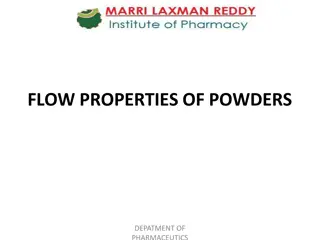Understanding Properties of Gases and Gas Laws
Gases exhibit unique properties compared to solids and liquids, including compressibility and variable densities. Pressure is defined as force per unit area, with common pressure units like atm, mmHg, and torr. Gas laws such as Gay-Lussac's Law, Boyle's Law, and Charles's Law describe the relationsh
4 views • 33 slides
Understanding Powder Flow Properties in Pharmaceutics
Powder flow properties play a crucial role in pharmaceutical manufacturing processes. Free-flowing or cohesive powders can lead to various challenges like uneven flow, caking during storage, and issues in dosing uniformity. Testing methods such as Carr's compressibility index and Hausner ratio help
0 views • 19 slides
Understanding the States of Matter and Properties of Gases
Matter can be classified into gas, liquid, and solid based on particle arrangement, shape, and motion. Gases in pharmacy are crucial for various applications like anesthesia and aerosols. Properties of gases include compressibility, pressure exertion, diffusion, and expansion. Gas laws such as Boyle
0 views • 22 slides
Wet Granulation Method in Industrial Pharmacy: Steps and Advantages
Wet granulation method in industrial pharmacy involves weighing and mixing ingredients, preparing a damp mass, converting it into wet granules, drying, dry screening, and mixing with lubricants. This method improves flowability, cohesiveness, and compressibility of powders, making them easily compre
0 views • 9 slides
Feasibility of Utilizing Tire-Derived Aggregate in Residential Basements
Conducted by Red River College in collaboration with Tire Stewardship Manitoba, this project explores the use of Tire-Derived Aggregate (TDA) sourced from recycled tires as backfill material for residential basements in Manitoba. The research focuses on investigating the compressibility, gradation d
0 views • 30 slides
Overview of Tablet Compression Processes and Granulation Methods
Powders for tablet compression must have good flowability and compressibility properties. Techniques like slugging and dry compaction are used in the production of tablets by compacting powders into granules. Dry granulation may lead to fines or non-compacted products, requiring cohesive properties.
0 views • 11 slides
Understanding the Behavior of Gases: A Comparison of Real and Ideal Gases
This chapter delves into the behavior of gases, contrasting real gases with the ideal gas model. It explores the P-V-T relationships of gases, highlighting the differences between ideal and real gas behaviors based on molecular properties. The critical point where coexisting gas and liquid phases co
0 views • 40 slides
AVATAR Project: Advancements in Aerodynamic Tools for Large Rotors
The AVATAR project, funded by the European Union's Seventh Programme, focuses on advancing aerodynamic tools for large wind turbines, specifically in the 10-20MW range. Led by a consortium of top research institutions and industry partners, AVATAR aims to elevate aerodynamic and fluid-structure mode
0 views • 16 slides
Understanding Tablet Production Methods and Properties
Tablet production techniques such as direct compression and granulation are essential steps involving powder milling, mixing, and tabletting. The use of crystalline structures and disintegrants impact the compressibility and flowability of tablets. Not all materials are suitable for direct compressi
0 views • 18 slides







